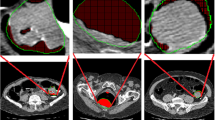Abstract
The application of deep learning (DL) methodology in the differentiation of benign and malignant lesions has drawn wide attention. However, it is extremely hard to acquire medical images with biopsy labeling, which leads to the scarcity of datasets. This is contrary to the requirement that DL algorithms need large datasets for training. To effectively learn features from small tumor datasets, a Bagging Strategy-based Multi-scale gray-level co-occurrence matrix (GLCM)-Convolutional Neural Network (BSM-GLCM-CNN) is proposed to boost the classification performance. Specifically, instead of feeding the raw image to the CNN, GLCM is used as the input of the designed model. As a texture descriptor, GLCM has the advantages of effectively representing lesion heterogeneity and of the same size for all input samples given the gray level. This work creatively partitions the GLCM to three groups to make full use of certain scale information of each group. When fusing the multi-scale texture information, the concept of bagging strategy in ensemble learning is used to improve the classification performance, where multiple base Learners are generated. Final classification results are obtained by integrating the multi-scale base Learners with the voting mechanism. Experimental results show that the proposed BSM-GLCM-CNN can successfully distinguish colonic polyps in a small dataset. The proposed method achieves an improvement from 68.00% Area Under Curve (AUC) to 90.88% AUC over other state-of-the-art models. The experimental results demonstrate the great potential of the proposed method when challenged by small pathological datasets in the medical imaging field.
Access this chapter
Tax calculation will be finalised at checkout
Purchases are for personal use only
Similar content being viewed by others
References
Yan, Z.: Multi-instance multi-stage deep learning for medical image recognition. In: Deep Learning for Medical Image Analysis, pp. 83–104 (2017)
Eddy, D.: Screening for colorectal cancer. Ann. Intern. Med. 113, 373–384 (1990)
Hao, X., Zhang, G., Ma, S.: Deep Learning. Int. J. Semant. Comput. 10(03), 417–439 (2016)
Sun, X., Wu, P., Hoi, S.: Face Detection using deep learning: an improved faster RCNN approach. Neurocomputing 299(JUL.19), 42–50 (2018)
Qin, H., Yan, J., Xiu, L., et al.: Joint training of cascaded CNN for face detection. In: 2016 IEEE Conference on Computer Vision and Pattern Recognition (CVPR). IEEE (2016)
Shen, D., Wu, G., Suk, H.I.: Deep learning in medical image analysis. Annu. Rev. Biomed. Eng. 19(1), 221–248 (2017)
Wang, H., Zhao, T., Li, L.C., et al.: A hybrid CNN feature model for pulmonary nodule malignancy risk differentiation. J. Xray Sci. Technol. 26(2), 1–17 (2018)
Tan, J., Huo, Y., et al.: Expert knowledge-infused deep learning for automatic lung nodule detection. J. X-Ray Sci. Technol. 27, 17–35 (2018)
Pawełczyk, K., et al.: Towards detecting high-uptake lesions from lung CT scans using deep learning. In: Battiato, S., Gallo, G., Schettini, R., Stanco, F. (eds.) ICIAP 2017. LNCS, vol. 10485, pp. 310–320. Springer, Cham (2017). https://doi.org/10.1007/978-3-319-68548-9_29
Liu, X., Hou, F., Qin, H., et al.: Multi-view multi-scale CNNs for lung nodule type classification from CT images. Pattern Recognit. (2018). S0031320317305186
Tan, J., Pickhardt, P.J., Gao, Y., et al.: 3D-GLCM CNN: a 3-dimensional gray-level co-occurrence matrix based CNN model for polyp classification via CT colonography. IEEE Trans. Med. Imaging PP(99), 1 (2019)
Ming, M., Wang, H., Song, B., et al.: Random forest based computer-aided detection of polyps in CT colonography. In: 2014 IEEE Nuclear Science Symposium and Medical Imaging Conference (NSS/MIC). IEEE (2016)
Lakshmanaprabu, S.K., Mohanty, S.N., Shankar, K., et al.: Optimal deep learning model for classification of lung cancer on CT images. Future Gener. Comput. Syst. 92(MAR.), 374–382 (2019)
Wong, S.C., Gatt, A., Stamatescu, V., et al.: Understanding data augmentation for classification: when to warp. IEEE (2016)
Qi, Y.: Ensemble Machine Learning. Springer, USA (2012)
Polikar, R.: Ensemble learning. Scholarpedia
Chen, Y., Li, D., Zhang, X., et al.: Computer aided diagnosis of thyroid nodules based on the devised small-datasets multi-view ensemble learning. Med. Image Anal. 67(1), 101819 (2021)
Fan, C., Hou, B., Zheng, J., et al.: A surrogate-assisted particle swarm optimization using ensemble learning for expensive problems with small sample datasets. Appl. Soft Comput. 91, 106242 (2020)
Hu, Y., Liang, Z., Song, B., et al.: Texture feature extraction and analysis for polyp differentiation via computed tomography colonography. IEEE Trans. Med. Imaging 35(6), 1522–1531 (2016)
Breiman, L.: Bagging predictors. Mach. Learn. 24, 123–140 (1996)
Hua, B.O., Fu-Long, M.A., Jiao, L.C.: Research on computation of GLCM of image texture. Acta Electron. Sin. 1(1), 155–158 (2006)
Author information
Authors and Affiliations
Corresponding author
Editor information
Editors and Affiliations
Rights and permissions
Copyright information
© 2022 The Author(s), under exclusive license to Springer Nature Switzerland AG
About this paper
Cite this paper
Zhang, S. et al. (2022). A Bagging Strategy-Based Multi-scale Texture GLCM-CNN Model for Differentiating Malignant from Benign Lesions Using Small Pathologically Proven Dataset. In: Li, X., Lv, J., Huo, Y., Dong, B., Leahy, R.M., Li, Q. (eds) Multiscale Multimodal Medical Imaging. MMMI 2022. Lecture Notes in Computer Science, vol 13594. Springer, Cham. https://doi.org/10.1007/978-3-031-18814-5_5
Download citation
DOI: https://doi.org/10.1007/978-3-031-18814-5_5
Published:
Publisher Name: Springer, Cham
Print ISBN: 978-3-031-18813-8
Online ISBN: 978-3-031-18814-5
eBook Packages: Computer ScienceComputer Science (R0)





